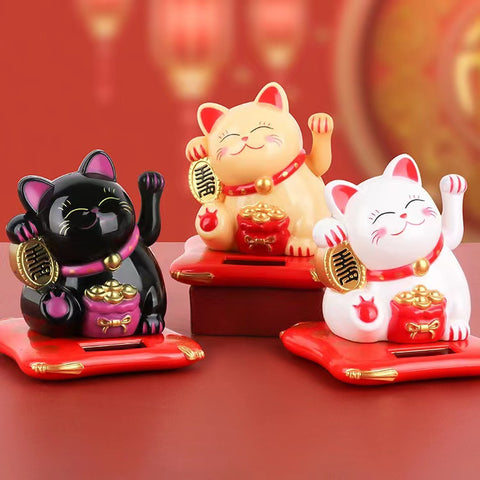Maneki-neko History and Using in Fengshui-Fortune Cat
Uncover the feng shui of Fortune Cat.
First, the correct use of Fortune Cat
1: color selection. Zhaocai cat is colorful. Many times we choose it according to our personal preferences. But temperament in Feng Shui, the different colors of Zhaocai cat represent different meanings. The white cat is meant to bring luck. The pink Fortune Cat is Cupid of love. It goes without saying that Tu Haojin's fortune cat is focused on wealth. The red Lucky Cat represents health. Blue Fortune Cat helps to work smoothly. The black cat is the moral of peace. Corresponding to the above meaning, when selecting, we should consider it in combination with personal needs.
2: Pattern selection. In addition to the different meanings of color, the pattern is also exquisite. Among them, the Lucky cat with treasure boat pattern is the moral of rolling wealth. The Lucky cat with Xiangying pattern symbolizes the realization of the dream and expresses hope. The tortoise crane pattern of Fortune Cat is the meaning of health and longevity. After knowing the meaning of the pattern, it is easier to make targeted choices when choosing!

3: Wear it with you. When it comes to Fortune Cat, many people will immediately think of the big head used for placement. In fact, Zhaocai cat can also be very small, which is convenient to carry with you. Common are mobile phone lanyards, car accessories, necklaces and jewelry. These small ones can help us improve our personal fortune and have the effect of attracting money!
4: Put the living room. A typical Fortune Cat is mostly used for display. If you want to bring fortune and happiness to your family, it's a good choice to place it in the living room. When placing the Fortune Cat, it's best to be close to the front door of the house and see it as soon as you enter the door. Or put it in a more eye-catching place in the living room, such as the TV cabinet. If it can be placed on the financial position in the living room, it must be excellent. It is better to sit north and face south. This arrangement helps to enhance the positive energy of the cat and protect the fortune of the family.
5: Store placement. The frequency of shops using fortune cats will be much higher than that of homes, because the former needs to rely on its fortune energy. When placing the shop, because Zhaocai cat is used to attract guests, it is best to place the door. If you choose the cat that raises your left hand, it means more customers and more money. If it is a cat who raises both hands or holds a cornucopia with both hands, it is the meaning of double income of wealth. The male cat holding his left hand is more suitable for placing shops or offices, which helps to attract wealth and prosperity.
The Japanese believe that maneki-neko can bring good fortune and luck to its owner. These figurines are usually made from plastic or ceramic and depict a Japanese Bobtail cat. They are commonly displayed at the entrance of restaurants and bars in order to attract customers. The lucky cat's paw is raised in a swinging motion and can be moved all day long.
The beckoning gesture is usually performed in Western culture by placing one's index finger out from one's clenched fist. In Japan, it involves folding the fingers down and back. The thumb moves toward the body as it attempts to draw someone closer.
The Japanese maneki-neko uses this gesture to attract customers and wealth. If its owner raises its arm, it will invite more people. On the other hand, if its right paw is raised, it will attract wealth and money.
WHAT DO THE DIFFERENT COLORS REPRESENT?
- White: Happiness, purity
- Black: Safety, wards off evil spirits
Due to its widespread popularity in Chinatowns, the Japanese version of the maneki-neko has been mistakenly labeled as Chinese. However, it's believed that this item first appeared during the Edo period. One of the earliest records of this type of figurine shows it being sold at a temple in Tokyo.
During the Meiji period, the maneki-neko was mentioned in a newspaper article. There were also reports about the item being distributed in a shrine in Osaka. In 1902, an advertisement for the item indicated that it became very popular during the early 20th century。
Despite the fact that feng shui is based in China, one can still successfully use various cultures' symbols and techniques. It’s important to be mindful of the different cultures' beliefs and practices when it comes to using these items, as well as to work with them intentionally.


